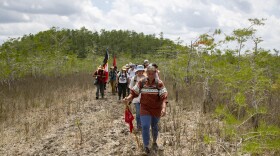
Tom Bayles
WGCU Environmental ReporterTom Bayles is WGCU's Senior Environmental Reporter and a 25-year veteran journalist in Florida. Before his tenure at WGCU Public Media, he worked for The New York Times Co. in Sarasota, the Associated Press in Miami and Tallahassee, and the Tampa Bay Times in Clearwater. He earned a master's in journalism and a bachelor's in education, both from the University of South Florida. The proud father of three sons, Bayles spends his free time fishing along the Southwest Florida coast in his 20-foot Aquasport with his Whippet pup, Spencer.
Bayles’ top awards include the Gold Medal for Public Service for Investigative Reporting from the Florida Society of News Editors, the Waldo Proffitt Award for Excellence in Environmental Journalism in Florida, and being named the Sunshine State’s top environmental journalist by the Florida Press Club and FSNE. Bayles has been nominated four times for a Pulitzer Prize.
Email: tbayles@wgcu.org
-
Bats keep the mosquito population down. But they also are an important sentinel species as their health and population trends provide an early warning system for broader environmental threats, including humans.
-
Charlotte County is asking its residents which environmentally sensitive lands should be bought with the dwindling dollars in the Conservation Charlotte program's coffers. Conservation Charlotte has bought critical wetlands, wildlife habitat, and water-resource lands for nearly two decades, but comes to an end in 2026
-
Landscape and architecture experts from the University of Florida will be on Sanibel Island next month to discuss how to lessen tropical storm damage on barrier islands by using what nature offers and climate change, stronger storms, and the loss of mangroves and sand dunes can make flooding worse — and how residents can turn things around to lessen the impacts.
-
Lawmakers aligned the districts with the state’s major hydrological zones, which leave some spread over a large area and leaving several counties split between two districts.
-
The National Audubon Society’s Christmas Bird Count is when volunteers fan out in groups to see what’s flying about. Audubon is looking for volunteer bird spotters throughout Florida to gather data that helps biologists protect birds and the environment in which they live
-
In November alone, more than 1.7 million people living in counties along or near Southwest Florida’s Gulf Coast were plunged back into a moderate drought. And drought often precedes wildfires.
-
Southwest Florida’s water managers have ordered the residents in 16 counties from Lee to Levy — along or near Florida’s Gulf Coast — to cut back on water use. The "Phase 1 water shortage restrictions” sound dire but leave in place local lawn-watering schedules as abundant as twice a week and appear to be more about priming residents for more severe weather conditions in 2026.
-
More than 250 conservationists and citizen advocates were in the audience at Audubon Florida’s 2025 Assembly. The state program of the National Audubon Society recognized people the group considers key environmental leaders from Naples to Orlando, and Tampa Bay to Panama City, at the annual event last month.
-
All three major forecasting institutions — AccuWeather, Colorado State University, and the National Weather Service, overpredicted total storm counts before the season, although all three correctly anticipated above-normal, major hurricane activity. But there will be no landfalling hurricanes in the U.S. in 2025
-
The Florida Forever Program has added another 16 square miles of land in Collier and Hendry counties for endangered species like the Florida panther to wander. Most of the land in Caloosahatchee-Big Cypress Corridor










